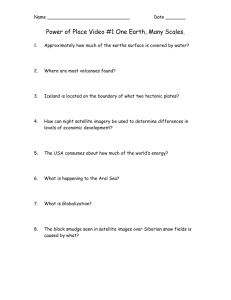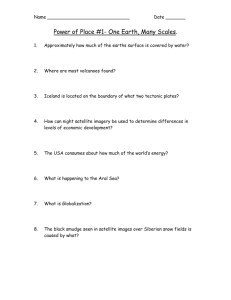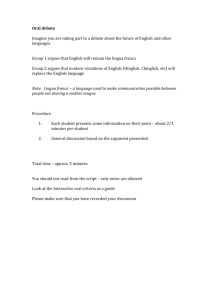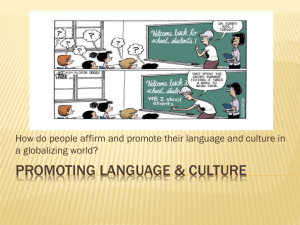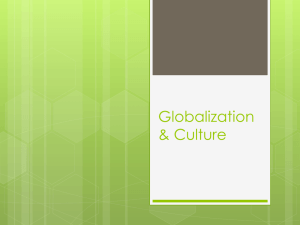Is it Globaliza,on that Endangers Languages?
advertisement
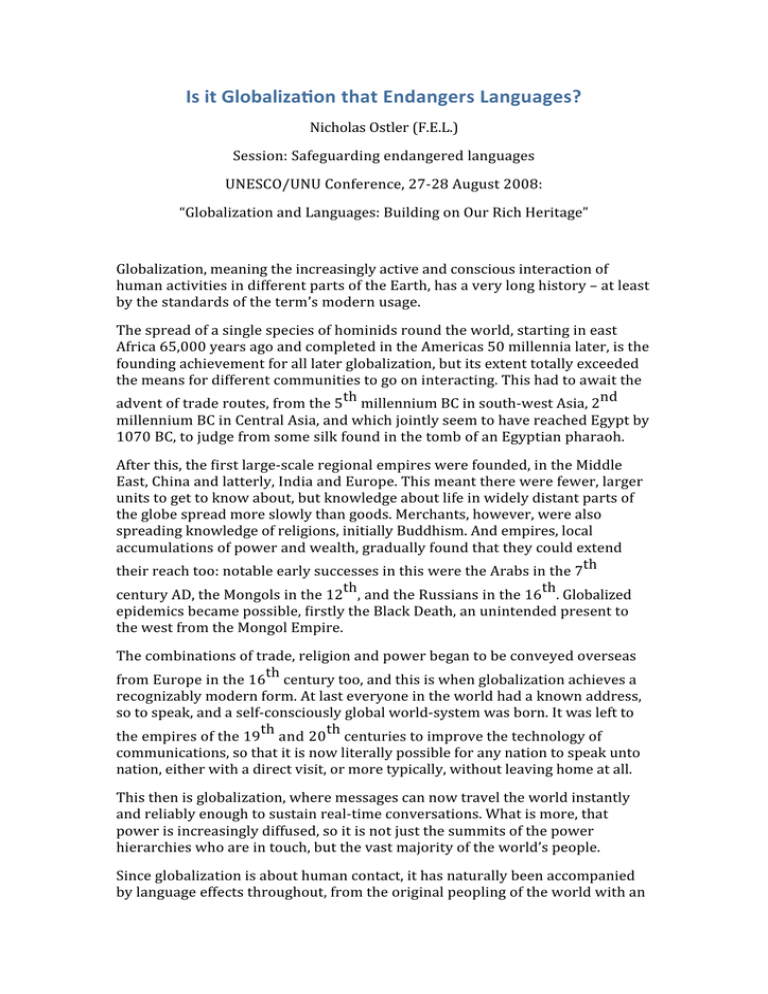
Is it Globaliza,on that Endangers Languages? Nicholas Ostler (F.E.L.) Session: Safeguarding endangered languages UNESCO/UNU Conference, 27‐28 August 2008: “Globalization and Languages: Building on Our Rich Heritage” Globalization, meaning the increasingly active and conscious interaction of human activities in different parts of the Earth, has a very long history – at least by the standards of the term’s modern usage. The spread of a single species of hominids round the world, starting in east Africa 65,000 years ago and completed in the Americas 50 millennia later, is the founding achievement for all later globalization, but its extent totally exceeded the means for different communities to go on interacting. This had to await the advent of trade routes, from the 5th millennium BC in south‐west Asia, 2nd millennium BC in Central Asia, and which jointly seem to have reached Egypt by 1070 BC, to judge from some silk found in the tomb of an Egyptian pharaoh. After this, the [irst large‐scale regional empires were founded, in the Middle East, China and latterly, India and Europe. This meant there were fewer, larger units to get to know about, but knowledge about life in widely distant parts of the globe spread more slowly than goods. Merchants, however, were also spreading knowledge of religions, initially Buddhism. And empires, local accumulations of power and wealth, gradually found that they could extend their reach too: notable early successes in this were the Arabs in the 7th century AD, the Mongols in the 12th, and the Russians in the 16th. Globalized epidemics became possible, [irstly the Black Death, an unintended present to the west from the Mongol Empire. The combinations of trade, religion and power began to be conveyed overseas from Europe in the 16th century too, and this is when globalization achieves a recognizably modern form. At last everyone in the world had a known address, so to speak, and a self‐consciously global world‐system was born. It was left to the empires of the 19th and 20th centuries to improve the technology of communications, so that it is now literally possible for any nation to speak unto nation, either with a direct visit, or more typically, without leaving home at all. This then is globalization, where messages can now travel the world instantly and reliably enough to sustain real‐time conversations. What is more, that power is increasingly diffused, so it is not just the summits of the power hierarchies who are in touch, but the vast majority of the world’s people. Since globalization is about human contact, it has naturally been accompanied by language effects throughout, from the original peopling of the world with an ef[lorescence of languages at the beginning of reconstructible history, to the immoderate spread of English in the 19th and 20th centuries. Indeed, the continental, and later global spread of certain languages is the clearest long‐ term evidence of what global contacts have been achieved. But this brings us, at last, to the question I want to address in this talk. We all know that in this modern world, alongside the languages that have become global, there are others – the vast majority – which have remained local in size and scope. There are close on 7,000 languages in the world, and half of them have fewer than 7,000 speakers each, less than a village. What is more, 80% of the world’s languages have fewer than 100,000 speakers, the size of a small town. These smaller languages are increasingly thought of as endangered, since all over the world they are failing to be taken up by young people. Now the question: Is it globalization, and the consequent spread of the global languages –above all at present, English – which is responsible for the endangerment of these other languages? I have dwelt at some length on the historical background of globalization, so that we can remember that this situation has been a long time in the making; and also to remember that there may be evidence about cause and effect which is not just from the last few decades when globalization has become extreme. To get a fairer, and less panicky answer to the question, we must [irst make the distinction between a lingua franca and a mother tongue. Not all languages have the same value to their speakers. When a language spreads as a lingua franca, this is a matter of convenience, making direct communication possible where before it was dif[icult because of a language barrier. The result is a larger community mediated by the lingua franca, with no corresponding loss of any other links. But when a language spreads as a mother tongue, this means that someone grows up with a language which is different from the mother tongue of one or both parents: some other mother tongue has lost a potential learner in the new generation. So whereas the spread of a lingua franca can only increase an effective ‘global’ community, the spread of a mother tongue may well decrease some local community. So only the latter contributes to language endangerment. A confusion arises because a language like English has gained many speakers in both these ways. In North America and Australia, most immigrants and most of the indigenous population have adopted English as a mother tongue, whereas, as a lingua franca, it is also widely used in countries which have never had a close political association with Britain. In many countries, though, such as India, Malaysia , South Africa or Nigeria, its status is more mixed and ambiguous. But consider a language like Esperanto, which only grows as a lingua franca: its spread is an asset to globalization, since it puts more people in touch with each other across the world, but it does not thereby replace any other linguistic competence. No‐one, and no language, need be afraid of Esperanto. This is one asset of a spreading lingua franca. Another one, potentially, is that it brings with it few, if any, cultural presumptions: it exists purely as a means of communication, not a badge of membership of a tradition. There seems to be an increasing impatience, in the world of Teaching English as a Foreign Language, with holding up the native speaker as an ideal, or accepting that any part of British or American culture is part of the subject. This cultural emptiness of a lingua franca is a matter of degree. There is a literature, including poetry, even in Esperanto. And people who learn any language in any way may derive from it some social bene[its beyond the ability to communicate: indeed, those who know a lingua franca which is not their mother tongue may often be recognized as an elite, having greater prospects and potentially greater power. This is in fact the rule, with second‐language learners of English, French or Russian. But this does not supplant their mother‐ tongue culture. They do not thereby have less access to their traditions. Nevertheless, the net effect of globalization may be adverse for minority languages, even if the spread of such lingua­francas does them no direct harm. Increasing and denser international contacts are likely to raise the general climate of aspiration and ambition within a territory. The results have often been a stimulus to imperialism in outsiders, nationalism in the local elite and urban masses, and centralizing economic development in both. All of these, by diminishing the role and independence of small traditional communities, usually damage minority languages. But this kind of damage is not by any means always brought about by the “usual suspects” among global languages, languages like English, French, Spanish, Portuguese, Arabic, Russian, Persian or Chinese. The Foundation for Endangered Languages’ conference in 2006, held in Mysore, southern India, focused on multilingualism as it affects endangered languages, and the relations revealed were very varied (Elangaiyan et al. 2006). In Nicaragua, the Tuahka language yields to its ancient neighbour Miskitu, unaffected by the recent overlays of English and Spanish. In Pakistan, urbanized Torwalis abandon their language for Pashto and Urdu, not English. The small Turung community in Assam are [inding that traditional pressures from Tai and Jinghpaw are morphing into new relations with Assamese and English; but the process is still too complex to have a predictable outcome. Matthias Brenzinger, in a wide‐ranging discussion of the language dynamics of southern and eastern Africa (Brenzinger 2007), admits that there are languages now growing there at the expense of smaller languages, but these are Amharic, Swahili, Setswana, not English, and perhaps Kirundi and Kinyarwanda owe their present unchallenged status as national languages to previous spread. Modern globalization can also bring about trends which are positive for minority languages. It can reveal the fact there are endangered languages all round the world, and so give their speakers a motive to contact one another, and build solidarity networks. It can spread ideas of how languages can reverse a downward trend, as Welsh, Maori and Hawaiian appear to have done recently in their different corners of the world, or breathe new life into the apparent husk of a dead language, as Hebrew did in the 20th century. On the solidarity front, there has been since 1978 the American Indian Language Development Institute (AILDI), with its mission is to document, revitalize and promote Indigenous languages, reinforcing the processes of intergenerational language transfer, and speci[ically organizing regular summer schools to train teachers. On the other side of the world, there are now winter schools to promote knowledge of the Latgalian language (de Graaf et al. 2008), closely related to Latvian, which has been transplanted to central Siberia, but which is now put back in contact with its erstwhile linguistic neighbours in Latvia. This kind of parallel development is only possible in a globalized world. The global trend of concern for endangered languages, wherever it may have started – if indeed it makes sense to look for a single source – has spread to in[luence governments and opinion‐formers worldwide. We can instance activities, selected randomly in just four continents. Here in Japan, there is now of[icial concern for the Ainu, where until 1997, and the Act for “Encouragement of Ainu Culture and the Diffusion and Enlightenment of Knowledge on Ainu Tradition”, there was only resignation, if not negative discrimination (though in fact, only on 6 June 2008 did Japan formally recognize the Ainu as an indigenous group). In Australia, since 1992 and the “Mabo” judgement which recognized Native Title and ended the doctrine of “Terra Nullius” – namely that no indigenous population had rights to territory before the advent of European claimants, of[icial attitudes to indigenous people have turned through 180 degrees, with an Aboriginal Reconciliation Commission in the 1990s and networks of “Australian Language Centres” set up in the 2000s. Although there was something of retrenchment under the Liberal administration, in 2008 the new Labor Government has issued a formal apology to them. In Peru and other Andean countries, there is increasing acceptance that indigenous populations need special support. There is a national programme in Peru of Educación Intercultural Bilingüe, and this is not just for the bene[it of the majority indigenous language Quechua. There is also AIDESEP (Asociación Interétnica de Desarrollo de la Selva Peruana) which focuses on the education of speakers of Amazonian languages. In Europe, the newly recognized duty to support minority languages has been cast into a treaty, which imposes speci[ic obligations on national governments if they are prepared to accept it. This is the ECRML, the European Charter for Regional and Minority Languages, adopted in 1992 under the auspices of the Council of Europe, and so far rati[ied by 21 states. Effectively it mobilizes a supranational, quasi‐global, organization in support of regional languages. Finally, one can mention the efforts of that quintessentially global organization, the United Nations. Since 1993 UNESCO's Intangible Heritage Section has had an Endangered Languages Programme, and in 2003 adopted a Convention for the Safeguarding of Intangible Cultural Heritage which recognizes the essential role of language in its expression and transmission. Other symbolic initiatives include the recognition since 2000 of 21 February as International Mother Tongue Day (the date originally commemorating the re‐institution of Bangla as of[icial in East Pakistan), and indeed 2008 as the International Year of Languages. It is over‐simple, then, and misleading, to cast Globalization as a direct cause of language endangerment. If one is concerned for this crisis, it is important to try to “remember the enemy”: not global languages themselves, for they are only an effect of globalization, and not necessarily in direct competition with languages that are endangered. What has led to the endangerment of languages is the imperialism, nationalism, and centralizing economic development, which are more about the concentration of power, and hence the disempowerment – and sometimes dissolution – of minority language communities. We have seen that, in current conditions, globalization, by unleashing new forms of human solidarity, gives some – modest – grounds for hope that these enemies of endangered languages can be resisted. Wade Davis has remarked that “Every language is an old‐growth forest of the mind, a watershed of thought, an ecosystem of spiritual possibilities.” Globalization provides endless opportunities for cross‐fertilization, but to get its bene[its as much as possible must survive of the different variant growths. The best thing that we can do for endangered languages is to do our best listen to the stories told in them, respect the people who tell those stories, and see them passed on to the next generation. In one or other old‐growth forest of the mind, we need to watch the trees grow. References Brenzinger, Matthias, ed (2007) Language Diversity Endangered. Berlin, New York: Mouton de Gruyter de Graaf, Tjeerd, Nicholas Ostler, Reinier Salverda eds (2008) Endangered Languages and Language Learning. Bath: Foundation for Endangered Languages. Elangaiyan, R., R. McKenna Brown, Nicholas Ostler, Mahendra Verma eds (2006) Vital Voices: Endangered Languages and Multilingualism Bath: Foundation for Endangered Languages.
